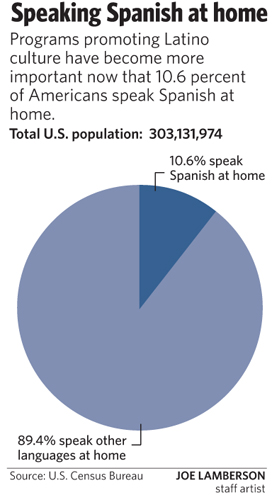Children learn Latino culture through stories

ME Online
October 18, 2007
The substantial growth of the Latino population in the United States in recent years has provided added cultural significance to programs such as Spanish Story Time at the Urbana Free Library that offer exposure to the Spanish language and Latin American cultures.
The event, founded last year, returned this past week after a summer hiatus.
“With the growth of the Hispanic population in the United States, it was an easy idea to pitch,” said Renata Johnson, outreach coordinator for the Center for Latin American and Caribbean Studies and organizer of the event. “A lot of libraries throughout the country have similar programs.”
A group comprised of students and faculty from the center facilitated the event, leading the children in organized sing-a-longs and story readings, first in Spanish and then translated into English. The program ended with a coloring session in which the children were given a map of South America and encouraged to locate specific countries.
“Today, it’s an absolute necessity for people to understand other cultures,” Johnson said. “This is a great opportunity to introduce children to the diversity that exists within Latin America.”
Get The Daily Illini in your inbox!
The U.S. Census Bureau reported a 3.4 percent increase in the Latino population between July 1, 2005 and July 1, 2006, making it the largest and fastest growing minority group in the United States. In addition, 78 percent of Latinos ages 5 and older speak a language other than English at home.
The library’s monthly program, sponsored and funded by the center, provides a venue in which Spanish-speaking and English-speaking children can learn a little bit about the culture of Spanish-speaking countries.
Silvina Montrul, professor of linguistics and specialist in second language acquisition, supports programs like Spanish Story Time because she said childhood is the most effective time for a person to learn a second language.
“Most people in this country don’t begin learning their second language until they’re in high school or college, which really hurts their chances at obtaining proficiency,” she said. “The earlier you start the better.”
While Spanish Story Time works to introduce English-speaking children to Spanish, the program also provides a venue in which children from Spanish-speaking homes can come to meet and socialize with other Spanish-speaking children.
Francisco Vivoni, a native of Puerto Rico, and Carmen Ocon, a native of Chicago, brought their 9-month-old daughter, Minerva, to the program because fun events for Spanish-speaking children are few and far between.
“We speak Spanish at home, and this was the first program of its kind that we had heard of,” said Vivoni. “We had a great time.”
Montrul praised the actions of Vivoni and Ocon and stressed the importance of maintaining bilingualism in the children of non-English-speaking parents.
“Too often the child loses their parents’ language after a while,” she said. “What we want is for children to be exposed to a second language but also to maintain the original one.”
Spanish Story Time aims to do just that, Johnson said.
“The idea is to provide Spanish exposure to English-speaking children but also to provide a space where Spanish speakers can feel valued and accepted,” she said. “That’s what we’re trying to do here.”






